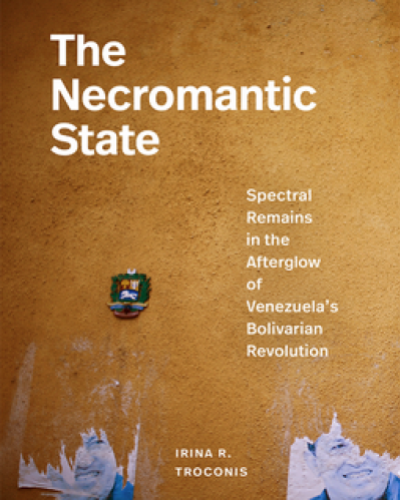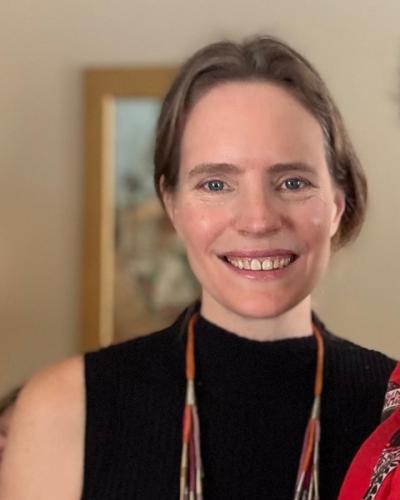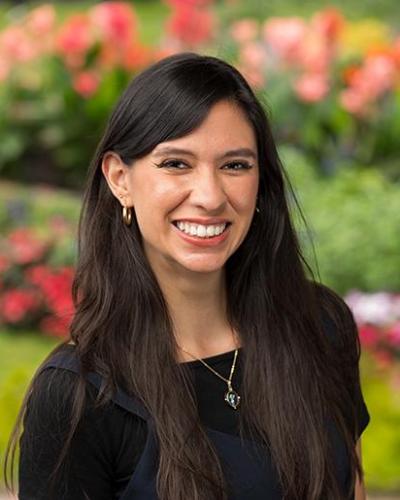The Fellows’ Q&A series continues with a spotlight on Irina Troconis. Irina Troconis is Assistant Professor of Latin American Studies in the Department of Romance Studies at Cornell University and 2021-22 “Afterlives” Faculty Fellow. Her book, The Necromantic State: Spectral Remains in the Afterglow of Venezuela’s Bolivarian Revolution (Duke UP, 2025), evolved out of research during the Fellowship year.
Big Picture:
The Necromantic State asks: in moments of uncertainty, political tension, and social crisis, how does the modern state mobilize the power of the dead to reclaim its legitimacy and ground its authority? To answer this question, the book explores the afterlife of Venezuela’s former president Hugo Chávez. Chávez, a pioneering figure of Latin America’s “Pink Tide” who began his presidency in 1999 and led the sociopolitical movement that came to be known as the Bolivarian Revolution, died on March 5, 2013, after a long battle with cancer. Following the announcement of his death on national television, a stencil of his eyes appeared everywhere—on buildings, streets, clothes, walls, stickers, jewelry—, his signature was reproduced as a tattoo and on apartment buildings and other housing projects sponsored by the government of his successor, Nicolás Maduro, an app—TC Chavez Pro—was developed that created a computer font using his handwriting, and his hologram was seen walking around Caracas on the night of December 8, 2016. These objects and images along with acts of doubling, mimesis, and repetition performed by both the government and the opposition—what I call “spectral remains”—created a state of haunting that tied the continuity of the government’s revolutionary project to Chávez’s spectral presence, which served both as an empowering force and one that, I argue, also placed and continues to place invisible yet sturdy boundaries on radical acts of political imagination. Each of the book’s first four chapters analyzes a constellation of Chávez’s spectral remains and sheds light on the relationship between spectrality, surveillance, intimacy, and playfulness. The last chapter and the book’s Coda turn to spaces that offer an opportunity to challenge the specter’s all-encompassing gaze by articulating a form of agency that is born not out of the vanishing or the banishing of the specter, but out of an unsettling, disloyal, and, most importantly, uncomfortable relationship with our heroic dead.
Ultimately, The Necromantic State offers a case study that allows us to think about the political and social life of specters, about what happens when ghostly matters are neither frightening nor subversive but behave instead as reassuring forces that protect the status quo, and about the work the people and the state do together that creates norms of existence that are internalized as common sense.
In Particular:
Chapter 3, titled “(Re)collecting Chávez,” analyzes a collection of objects that include a set of disposable phone cards created as part of a collaboration between graphic designer and cartoonist Omar Cruz and CANTV (the state-run telephone and internet service provider in Venezuela) that show different moments of Chávez’s life, Chávez’s signature on the walls of buildings constructed by the Gran Misión Vivienda Venezuela and reproduced as tattoos, and the app TC Chavez Pro. I read the creation and circulation of these objects alongside the debates that took place after Chávez’s death regarding, on one hand, the question of who had the right to call themselves Chávez’s “true” heirs, and on the other, the economic crisis and Maduro’s own decreasing popularity, both of which threatened to put the continuity of the Bolivarian Revolution at risk. In response to this, members of Chávez’s family started occupying positions of power, and Chávez’s image was commodified, incorporated into basic products like milk and other goods that the government distributed as part of its social programs. The app, the phone cards, the tattoos, and the signatures on buildings, I argue, also responded to this uncertainty regarding legacy and the void in power by consolidating and, in some instances, creating a familial link between Chávez and the people who engaged with these objects and images. This link both compensated for and distracted from the fractures within chavismo’s officialdom and strengthened Chávez’s spectral presence by ensuring that it moved seamlessly between public and private spaces.
In the case of the collectible phone cards, Chávez moves from the streets into the family album through a process of miniaturization that extracts him from the domain of the state and its official narratives and rescales him to fit within the narrative of a family history. The second object I analyze is the result of the reverse operation: Chávez’s signature becomes gigantic as it is drawn on buildings constructed by the Gran Misión Vivienda Venezuela. I argue that this iteration of the signature stages a sort of spectacular temporal collapse that ensures that Chávez afterlives in the repeated and seemingly magical fulfillment of his promises, and that debt and gratitude appear wrapped around each other. The other iteration I discuss—the signature being reproduced as a tattoo—creates a bond that is deeper, more intimate, than the familiality produced and reproduced through the collectible phone cards. As a tattoo, Chávez’s authority becomes part of the body, and his presence, as a scar, does away with the need for remembrance and allows instead for a haunting from within that is normalized as a life-infusing, organic, intimate form of cohabitation. Lastly, I bring up the app TC Chavez Pro, which, by reproducing Chávez’s handwriting as it appeared not in moments of certainty and relief, but in moments of doubt, uncertainty, and hope, allowed for the feeling of participation in a living history where the potentiality of the known past could be experienced anew. I conclude the chapter by arguing that what connects all these objects is not only the rendering of a sort of intimacy and familiality that allows the specter to move from the public domain of the state into the private space of the family, the body, and the home, but also the performing of an unactualized state that makes imagining the future feel like déjà vu and remembering the past feel like remembering something yet to come.
Discovery:
Except for the stencil of Chávez’s eyes, which I had seen before going to Venezuela in 2016 to conduct research for the book, every object that I write about was a surprise for me. Chávez’s spectral remains do not exist in a pre-established archive; finding them required visiting official places of commemoration, such as Chávez’s tomb in the Cuartel de la montaña and the National Pantheon, and also having casual conversations with people both pro-government and in the opposition and wandering around and getting lost in the streets of Caracas and Mérida. Put differently, conducting the research for this project required both hunting down Chávez’s specter, and being haunted by it. This inspired me to think, often and deeply, about what sort of method there is to write about ghosts and specters when they are not conceptual metaphors or figments of the imagination, but political and social actors with a public and visible presence. It also inspired me to think about what it means to be as vulnerable to your object of study as the object of study is vulnerable to your analysis of it. These questions, in turn, shaped the way the book is written and my decision to include “vignettes” that allowed me to reflect on my own complicated relationship with Chávez’s spectral remains, some of which actually came with me in my suitcase when I returned from Venezuela, and are now part of a collection that I did not ask for, but that nevertheless exists in my office as a reminder of those moments in one’s research journey that interpellate us precisely by shattering our illusion of control.
Fellowship:
This book would not exist without the illuminating conversations I had with the “Afterlives” fellows. Being part of a group of brilliant colleagues, all interested in afterlives yet each approaching the topic from their very own unique perspective, encouraged me to engage with theoretical and disciplinary questions I had not thought of before, and to consider who my audience was and what it would mean to write a book that would speak to many disciplines. That was the year I learned to feel comfortable giving and receiving feedback, and the year I learned the value of thinking with others in a collective space that was simultaneously challenging and welcoming. Moreover, the course I taught, titled “Specters of Latin America,” allowed me to rehearse my arguments with an incredible group of students who pushed me to think more seriously about the distinction between “ghost” and “specter,” which ended up being one of the central theoretical propositions of the book. All in all, it was a formative year for me, and one that will keep informing how I think about my scholarship in the future.







